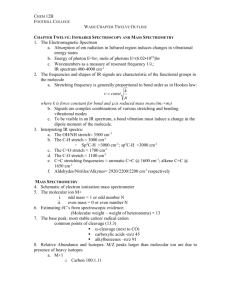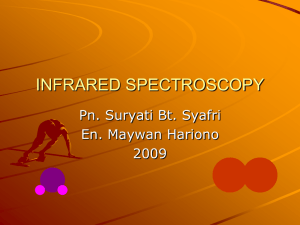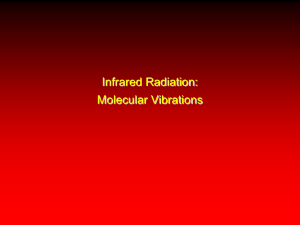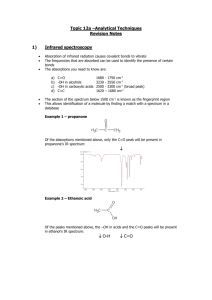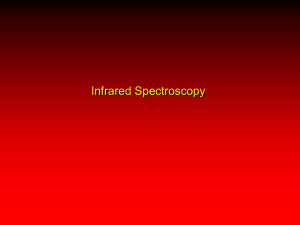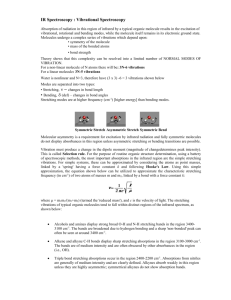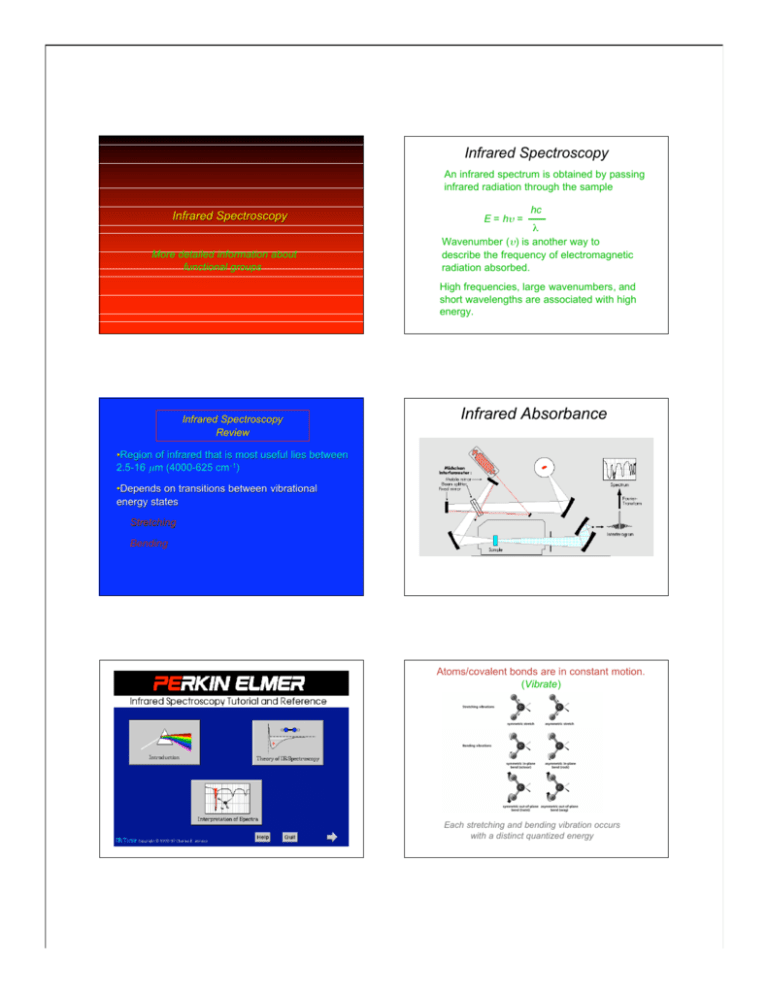
Infrared Spectroscopy
An infrared spectrum is obtained by passing
infrared radiation through the sample
Infrared Spectroscopy
More detailed information about
functional groups
E = hυ =
hc
λ
Wavenumber (υ) is another way to
describe the frequency of electromagnetic
radiation absorbed.
High frequencies, large wavenumbers, and
short wavelengths are associated with high
energy.
Infrared Spectroscopy
Review
Infrared Absorbance
•Region of infrared that is most useful lies between
2.5-16 µm (4000-625 cm-1)
•Depends on transitions between vibrational
energy states
Stretching
Bending
Atoms/covalent bonds are in constant motion.
(Vibrate)
Each stretching and bending vibration occurs
with a distinct quantized energy
Infrared Absorbance & Molecular
Vibrations for CCl4
Stretching & Bending
Stretching Vibrations
Symmetric
Bending Vibrations
In plane
Bending Vibrations
In plane
Stretching takes more energy than bending.
Antisymmetric
Out of plane
Out of plane
Bond order affects the position of absorption bands
The approximate wavenumber of an IR absorption
peakcan be calculated from Hooke’s law
υ~ = 1
2πc
υ~
f
f(m1 + m2) 1/2
m1m2
= the wavenumber of the stretching vibration
= force constant
m1 and m2 = masses of the respective atoms
Empirical Table
Infrared Absorption Frequencies
Structural unit
Frequency, cm-1
Stretching vibrations (single bonds)
IR
Hexanol
2IR Spectrum
Spectrum of
of 2-Hexanol
2-Hexanol
O—H (alcohols)
3200-3600
O—H (carboxylic acids)
3000-3100
N—H
3350-3500
o
IR
IR Spectrum
Spectrum of
of aa Primary
Primary Amine
Amine (1
(1 o))
H—C
O—H
CH 3CH 2CH 2CH 2CHCH3
OH
3500
3000
2500
2000
1500
1000
500
Wave number, cm-1
•A bond must have a dipole or an induced dipole in order
to have a visible absorbance in the IR spectrum.
•The energy (IR frequency) and intensity of the
absorption band also depends on the concentration
of the solution from Beer’s law, A= εbc.
•When a bond stretches, the increased distance
between the atoms increases the dipole moment
•Therefore, it takes less energy to stretch an O–H or
N-H bond if it is hydrogen bonded.
•Therefore, the greater the dipole, the more intense the
absorption. (i.e., The greater the molar extinction
coefficient (ε) in Beer’s law, A= εbc)
Empirical Table
Infrared Absorption Frequencies
Question
What is the difference in the O-H stretching
peak between a 1o alcohol’s liquid phase
spectrum and its spectrum in the gas
phase?
A) none
B) The gas phase peak is more intense.
C) The gas phase peak is >4000 cm-1.
D) The gas phase peak is much less
intense.
Structural unit
Frequency, cm-1
Stretching vibrations (single bonds)
sp C—
C—H
3310-3320
sp2
C—
C—H
3000-3100
sp3 C—
C—H
2850-2950
sp2
1200
C—
C—O
sp3 C—
C—O
1025-1200
Empirical Table
Infrared Absorption Frequencies
IR
IR Spectrum
Spectrum of
of Hexane
Hexane
Structural unit
Frequency, cm-1
Stretching vibrations (multiple bonds)
bending
C—H stretching
bending
C
bending
CH 3CH 2CH 2CH 2CH 2CH 3
3500
3000
2500
2000
1500
1000
500
Wave number, cm-1
C
1620-1680
—C
C—
2100-2200
—C
N
2240-2280
Empirical Table
Infrared Absorption Frequencies
IRSpectrum
Hexene
1IRSpectrum of
of 1-Hexene
1-Hexene
Structural unit
Aldehydes and ketones 1710-1750
H—C
H2C=C
H2C=CHCH 2CH 2CH 2CH 3
3500
3000
2500
C
Stretching vibrations (carbonyl groups)
C=C
C=C—
C=C—H
Frequency, cm-1
2000
1500
cm-1
Wave number, cm
1000
500
Esters
1730-1750
Amides
1680-1700
Carboxylic acids
1700-1725
Acid anhydrides
1800-1850 and 1740-1790
O
•An atom other than carbon next to the carbonyl
group causes the position of the carbonyl absorption
band to shift
IR
Hexanone
2IR Spectrum
Spectrum of
of 2-Hexanone
2-Hexanone
CH 3CH 2CH 2CH 2CCH 3
•The nitrogen of an amide is less electronegative.
1680-1700 cm -1 (longer C=O bond)
O
H—C
•The oxygen of an ester is more electronegative.
1730-1750 cm -1 (shorter C=O bond)
C=O
3500
3000
2500
2000
1500
1000
500
Wave number, cm-1
Francis A. Carey, Organic Chemistry, Fourth Edition. Copyright © 2000 The McGraw-Hill Companies, Inc. All rights reserved.
Empirical Table
Infrared Absorption Frequencies
What would explain the difference in the C=O stretching
absorbances between an anhydride 1800-1850 cm -1 and
1740-1790 cm -1 and a carboxylic acid 1700-1725 cm -1?
Frequency, cm-1
Structural unit
Bending vibrations of alkenes
RCH
CH2
910-990
R 2C
CH2
890
cis-RCH
cis-RCH
~ 1720 cm -1
CHR'
trans-RCH
trans-RCH
(1725-1700 cm -1)
R 2C
CHR'
CHR'
665-730
960-980
790-840
Question
Is the following IR of cis or trans 2pentene?
wavenumber (cm –1)
3075
2950
1650 and 890
assignment
sp2 CH
sp3 CH
a terminal alkene with two substituents
A) cis
B) trans
Distinctive Stretch of C–H Bond in an
Aldehyde (the “waggle” vibration)
SUMMARY:
C–H bond absorption
and hybridization
of the carbon atom
Empirical Table
AROMATIC IR Absorption Frequencies
Structural unit
IR
-butylbenzene
tert
IR Spectrum
Spectrum of
of terttert-butylbenzene
Frequency, cm-1
Bending vibrations of derivatives of benzene
Monosubstituted
730-770 and 690-710
Ortho-disubstituted
Ortho-disubstituted
735-770
Meta-disubstituted
Meta-disubstituted
750-810 and 680-730
Para-disubstituted
Para-disubstituted
790-840
Ar—
Ar— H
C6H5C(CH 3)3
H—C
3500
3000
2500
Monsubstituted
benzene
2000
1500
Wave number, cm-1
Analyzing Structure:
Functions & Infrared Spectra
Question
The following IR is most likely?
The molecular formula is a critical piece of
information, which limits the functional possibilities.
The presence & absence of absorption bands are
must be considered in identifying a possible
structure in IR spectroscopy.
NOTE: Bonds, which lack dipole moments, are
not detected.
A) o-xylene
o-xylene
B) m-xylene
m-xylene
C) p-xylene
p-xylene
D) ethyl benzene
1000
500
Subtle differences can make some distinctions very difficult.
Analyzing Infrared Spectra :
Structure & Function Questions
Therefore IR is used with other methods; NMR being most important.
Question
The following IR is most likely?
A) methylbenzamide
B) benzoic acid
C) methylphenylketone
D) ethyl benzene
E) benzaldehyde
Question
The following IR is most likely?
A) methylbenzamide
B) benzoic acid
C) benzaldehyde
D) ethylbenzylketone
E) methylbenzoate
Question
The following IR is most likely?
A) propylamine
B) propenoic acid
C) 2-propanol
2-propanol
D) 2-propenaldehyde
2-propenaldehyde
E) 2-propyne
-1-ol
ol
2-propyne-1-


